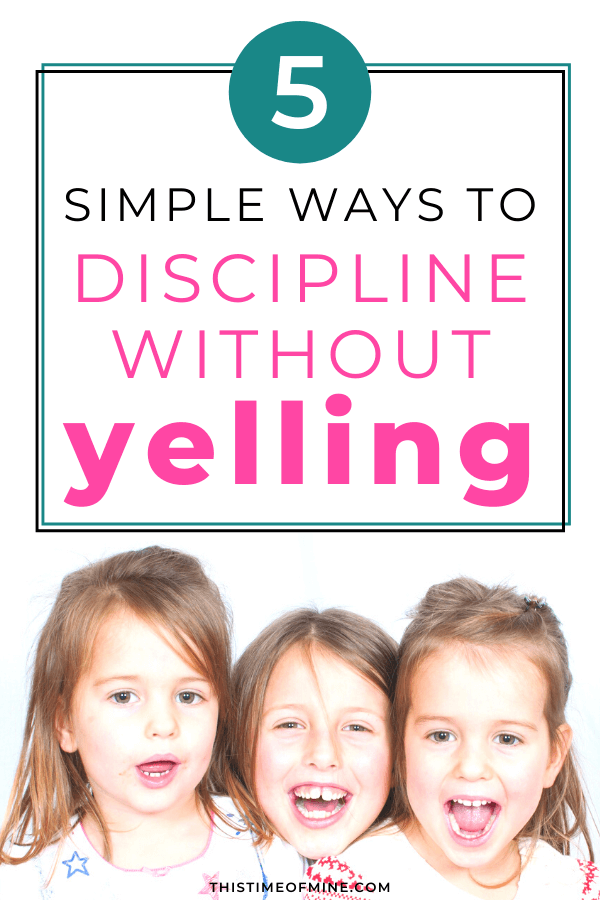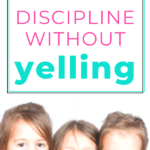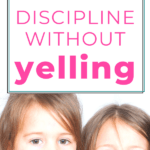5 Simple Ways To Discipline Without Yelling
Want to discipline without yelling, but don’t know where to start? Try these 5 simple tricks for an effective way to get kids to listen the first time!

Do your kids ever make you feel like you speak a different language? Like, one from a different planet?
Because no matter what you try, no one is listening.
On days like these, the only logical option seems to be yelling.
I mean, what else can we do? We can’t possibly control our emotions, get our kids to listen, AND achieve positive results. At least not at the same time, right?
Making the impossible possible
Staying calm while disciplining might seem like something out of a fiction book. And it’s too easy to fool ourselves into thinking we’re just another angry mom. And there’s nothing that can be done about it.
But we’d be wrong.
The cycle of anger and yelling is a problem that all of us are familiar with. Being a parent is hard work and sometimes, our kids make us want to rip our hair out.
But believe it or not, the problem isn’t you. It’s not even your kids.
Ever heard the saying, “Knowledge is power”?
Well, that’s true in parenting as well.
None of us started off as mom experts. We learn as we go, little by little, experience by experience. We slowly add tricks and hacks to our parenting toolbelt until we find what works for our personality and parenting styles.
It’s possible to effectively discipline our kids without yelling at them all the time. But it takes more than just telling ourselves to stop yelling. We need strategies and tips we can experiment with until we find what works.
Of course, that doesn’t mean we can read a quick article like this and be cured. But it’s a great place to start!

5 WAYS TO DISCIPLINE WITHOUT YELLING
Trying out a new parenting strategy can feel awkward at first. But, like anything new, the more you do it, the easier it gets!
Here are 5 easy techniques to try:
1. Validate, then explain
The first technique is to validate their feelings before explaining why they’re in trouble.
“You just don’t understand!”
Have you ever heard that one as a parent? If you haven’t yet, just wait. It’ll happen eventually.
Our kids want to be understood, no matter their age. They want to know that the big feelings they’re having are normal and that everything is going to be okay.
They crave validation.
So before skipping straight to the lecture, show that you understand, or want to understand what they’re feeling. Their little bodies can house some pretty big emotions. And often, they simply don’t know what they are or what to do with them.
Try validating statements such as,
- “I know that must be frustrating.”
- “I’m so sorry he made you mad.”
- “I understand you’re disappointed.”
- “I know, it’s such a bummer.”
Want to take it even further? Ask questions instead.
Rather than naming the feelings for them, ask them to describe how they’re feeling and talk through it together.
Once their feelings have been validated, they’ll be more open to trust and listen to you. Now you can start to explain why their behavior or action wasn’t the best choice and how they can do better next time.
2. Empathize, then discipline
The second technique is to offer an empathetic statement followed by a logical consequence.
Our kids are more likely to rebel and resist if we’re always rushing in and threatening consequences. Instead, start with a simple statement using words like “I know”, “I’m sorry”, or “I understand” to show empathy.
This technique is similar to the one above, except instead of explaining why a behavior or action is wrong, you give a consequence.
But be sure to keep the consequence related to the behavior.

3. Acknowledge, then problem-solve
The third technique is to acknowledge that something is wrong, and then have them help you figure it out.
One of the quickest ways to get a child to lie or shut off is to present them with a yes/no question when they’re in trouble.
- “Did you sneak a cookie?”
- “Did you hit your sister?”
- “Did you just climb on the counter?”
- “Do you want me to ground you from your tablet?”
No!
When we’re presented with an accusation or threat, our quickest reaction is usually to get defensive. It’s human nature.
So rather than stating what you already know, have your kids help bring the problem out of the dark. Describe what you see and use leading questions to help kids describe to you what happened.
Then come up with a logical consequence together.
4. State the fact, then have them try again
The fourth technique is to remain neutral while stating that their behavior isn’t working, and then offer them the chance to try again.
Whining, stomping off, backtalk, hitting…there are so many behaviors that make us angry. But if we want to effectively discipline without yelling, we have to hold off on that anger, and help our kids understand what we expect instead.
Here are a few examples:
- “Sorry, that’s not how we ask for a drink. Try again.”
- “I know you’re mad, but stomping off isn’t nice. Come back and try walking out a different way.”
- “That’s not how we speak to each other. Try again.”
- “We don’t use our hands for hitting. Try tapping your sister’s shoulder instead next time you need her attention.”
Keep at it until you get the result you want – no matter how many times it takes!
My daughter used to have the worst problem with stomping off. She would have to try walking out again and again, often so many times that we’d both end up giggling because it was so ridiculous. But she got the point!
5. Catch them off guard, then connect
The last technique is to get their attention by doing something totally different, and then taking a moment to connect with them.
Sick of your kids not listening? Instead of yelling, do something unexpected. Use humor, whisper, react in a way they won’t expect…anything to get their attention!
Once you’ve got their attention, use the opportunity to connect. There are so many times when behavior issues are directly related to our children’s need to connect with us that day.

The best way to discipline is to skip the yelling and make a sandwich.
However you decide to discipline, keep in mind that teaching is most effective when we use the “discipline sandwich” – or a lesson sandwiched in love.
When we start with love, we reinforce that the relationship is one of trust. It allows parents and children to meet in the middle – in a place of safety. And kids are much more receptive when this is established.
And when we end with love, our kids will know that their actions, and the discipline that followed, won’t affect your love for them.
Disciplining with this approach helps our kids understand the natural relationship between behaviors and consequences and empowers them to understand that improvement is in their control. And that you’re right there ready to help.
WANT EVEN MORE WAYS TO DISCIPLINE WITHOUT YELLING?
It’s hard to break the habit of yelling at our kids. Trust me, I’ve been there.
But I’ve found that the more actionable strategies and tips I can try, the better prepared I am the next time my patience is tested.
Because yelling simply doesn’t work, not in the long run anyway.
Want more tips on breaking the yelling cycle? Try these posts:
- The Surprising Reasons You Yell At Your Kids
- How To Keep Your Cool When Kids Won’t Listen
- Do This, Not That: 10 Powerful Alternatives To Yelling
want to remember this?
PIN IT TO YOUR FAVORITE BOARD
Share this article:


